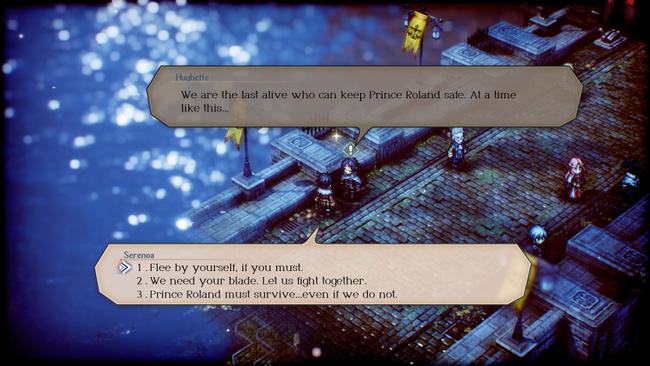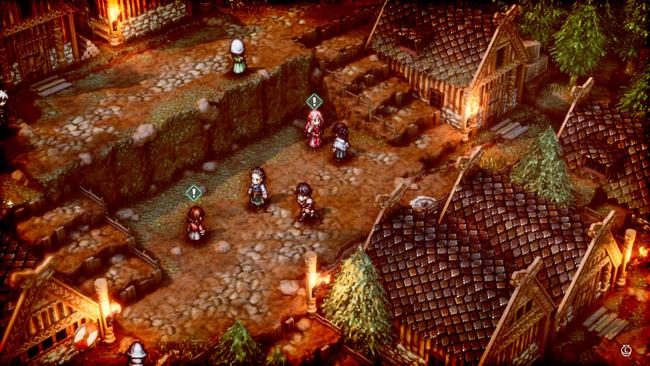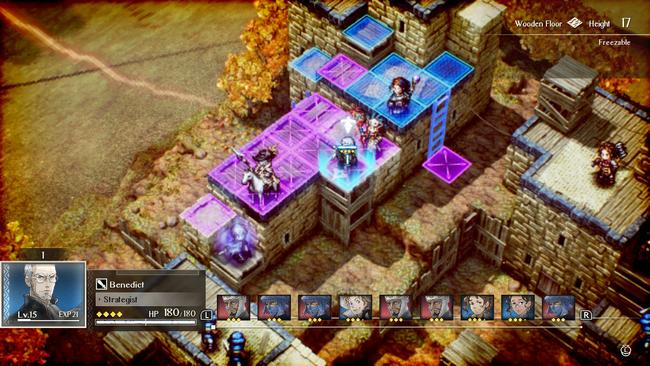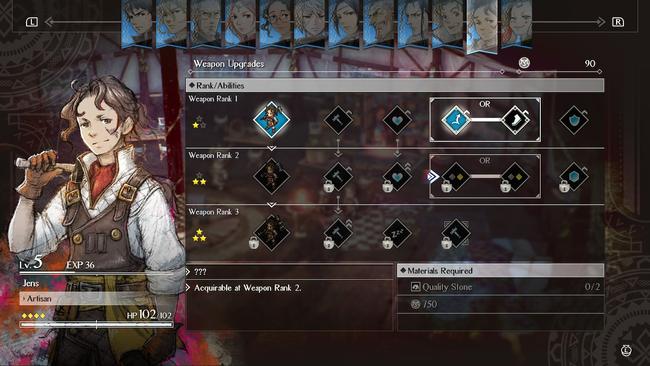
Triangle Strategy Review
2022 seems like it could be a great year for tactical RPGs as Square Enix’s Asano Team kicks things off with Triangle Strategy. I can’t claim to be a lifelong diehard who was there in the SNES and PS1 eras, as I was far too young during that time, but I’ve been a big fan of the SRPG genre for years.
I will admit though, it sometimes takes quite a lot for SRPGs to click with me. Many use obtuse difficulty as a crutch for poor game design, but a strong story can do a lot to get you over the challenge hump and the nature of the genre practically begs for creative political war-themed narratives. Final Fantasy Tactics and Tactics Ogre in particular are still beloved today for that exact reason.
When you’re trying to evoke the spirit of those two games, expectations will be high. Triangle Strategy, intentionally or not, seems to be doing just that. It would be narrow-minded to only draw comparisons to those games, but I also think it’d be ignorant to say some of the comparisons aren’t fair. The tone of the story and gameplay echoes these classics, and there’s nothing wrong with that. What’s important is how Triangle Strategy lives up to the premise of an SRPG revival, and how it stands on its own merit.

On the continent of Norzellia, the player steps into the shoes of a young noble named Serenoa Wolffort. Unbeknownst to him, Norzellia is on the eve of war breaking out, with House Wolffort being in the dead center of the conflict. Serenoa cannot navigate this conflict without your help, as his opinions on the alliances he makes depend solely on the decisions you make.
There are three major morality values the game centers on: Morality, Utility, and Liberty. Almost everything you do will raise Serenoa’s convictions for one of these three values. How these values directly affect your playthrough are deliberately kept vague, acting mostly in the background. Your choices can change a lot that I can’t get into, but in gameplay, it can decide which side characters can join you. Decisions will affect this the most, and you’ll often get moral questions sprinkled throughout the cutscenes in each chapter.
Voting is the major mechanic that branches your story, and it can eventually decide the ending you get. Including Serenoa, there are seven party members that have a coin that lets them vote on important decisions the group needs to make. Who to side with, where to go, what battle tactics to take, and more moral dilemmas that are meant to really push the player’s convictions. It can succeed in doing this often, making the narrative in the early hours captivating.

You’ll need to gather information to manipulate the voting in your favor, which you do during exploration segments. Most of the strategy games that Triangle Strategy draws inspiration from simply move from scenes to battles and back. However, in recent years, more and more games like this add some focus to offer players downtime by having them roam a hub area. Triangle Strategy fully utilizes the 3D maps by offering a similar experience.
During specific points in the story, Serenoa will get to freely walk around an area that will most likely (but not always) end up being a future battle map. NPCs can give you information on what's happening in the world, which he takes notes on. You can then use this to unlock dialogue choices when trying to get his friends to vote in the way you want. If you aren’t thorough enough in your exploration, you won’t get the story to play out in your favor. While I think these can be where the game shines the brightest, the locations in my playthrough were reused almost ad nauseam the further I got into the game.
The way Triangle Strategy handles morality is a bit of a disappointment, leading to some jarring bumps on the road of narrative. At times, it feels like the writers tried to make things more complicated than they needed to be, in order to adhere to the game-y structure of needing every major decision to fall under one of the three categories. Additionally, besides Serenoa, there are three other primary characters - Roland, Frederica, & Benedict - who each represent one of the three morality axes.
I think this oversimplification of morality weakens the story’s impact and can make the consequences of your decisions predictable. There’s also a problem where, in my opinion, the way the morality system is implemented in the story skews in favor of Frederica. I’m sorry, but I found her to be correct pretty much every time these conflicts popped up. It made my playthrough harder, which was a great consequence for her kind of paths which focus on limiting casualties and fighting for the wellbeing of the innocent. The other two have their benefits, but my Serenoa loved his wife. Which he should, she’s great.

Where the morality and voting systems hurt the story the most for me was Serenoa himself. Because of the way voting works, Serenoa can never feel too strongly about anything that happens in front of him. To ensure the system works naturally with the narrative, he needs to be a Schrödinger’s Protagonist, both staying natural and also agreeing with multiple extreme perspectives at once that don’t mesh in the slightest. When met with horrible things like war crimes, slavery, and more Serenoa has to be generally ambivalent until a voting segment takes place, where he will then finally feel passionate about whatever you choose. It adds to the decision gimmick which vastly improves replayability, but I think it makes his character lack agency.
When it comes to tactics and combat, Triangle Strategy doesn't quite mimic an exact style of game but instead picks and chooses from several. It has the physics of Tactics Ogre, the pace of Final Fantasy Tactics, and a class upgrade system most reminiscent of Fire Emblem. Often this mishmash works wonderfully; battles are addicting and I couldn’t put the game down for the first weekend I had my eager hands on it. They can be hard, brutally so if you want to play on normal without doing mock battles in the base camp to grind EXP and items. There’s no permadeath, however, which might disappoint hardcore strategy game fans.
The most interesting quality of life improvement I experienced with my time playing Triangle Strategy is how it handles retreating from battles. We’ve all been there. Stuck near the end of a battle, realizing you’ve screwed yourself over with your tactical choices. As much as you earned that outcome, it still sucks knowing you blew maybe up to an hour of progress and EXP. In Triangle Strategy, you can retreat from battles and retain all EXP gained. So if you gained levels during a mission and want to tackle it again you can do so with an edge. I can see how people might not like this, but I adored it. I never felt like I hit walls I couldn’t get over, and you don’t have to use it if you don’t want to. Plus, you can change the difficulty at any time if you want to adjust the challenge at any time.

Most of the missions focus on routing the enemy, but it mixes things up mainly with some brilliant map design. My favorite map of the game is a mine with functioning mine carts. Anyone on the tracks will take damage if friend or foe uses it, but it doesn’t stop there. Since the tracks are made of metal, electricity spells will hit anyone on there as well. I love this detail, and the way magic can be used on environments in realistic ways is consistently fun. Top this all off with a constant side objective to prevent bombs from going off while you rush to defeat the boss of the map, and this mission really stood out to me. This was the game at its peak to me, and even if most never got this creative in my playthrough they implement aspects of these ideas across the experience.
A small detail vital for making a good turn-based strategy game is having the mechanics feel snappy, and they nailed this. It plays out like you’d expect from one of these, with a standout mechanic being the pincer attack system. If you surround an enemy with two units in attacking range (this includes archers), both of them will get an attack during one turn. Enemies can do this as well, so relying on this without thinking of the placement of your enemies could put you at a disadvantage.
Your team composition is important, and since everyone has a strict class and upgrade path, it at least keeps things balanced. I wish there were at least multiple branches your characters could upgrade into, but with equipment and accessory slots you aren’t going to be lacking for choice in terms of customization. The game might be lacking some complexity here, but it’s very well made. The main cast are all very generic fantasy classes, but there are a lot of unique ones you can recruit optionally. My favorite in the entire game is possibly even unique to the genre. You can recruit the initially unnamed blacksmith in your camp, who then gets a name as soon as he joins. His name is Jens, and he specializes in placing traps that play excellently with the fall damage mechanic inspired by Tactics Ogre. He’s slow, but he came in clutch more often than I could count.

One thing I did not quite expect going in is that the ratio of cutscenes to battles felt a bit lopsided in favor of the dialogue. Most of your time in a chapter is spent watching cutscenes, so much so that you can easily burn out if you plan to binge the game. However, if you’re playing this primarily for the story, this may not be a critique at all, so take that as you will.
On the audio side of things, I think it’s Triangle Strategy hits a home run. The soundtrack stands up strongly compared to the titans of the genre and makes battles tense. Sound design is strong, giving all your hits and magic attacks a sense of weight to them. The voice acting, especially on the English side, is solid even if it took me a while to get used to it. Every cutscene outside of exploration dialogue is fully voiced, which is impressive, because as I said, there are a ton of cutscenes.
As an HD-2D title, it's far more refined than Octopath Traveler even if the Switch still holds it back just a bit. You can turn off the depth of field and the corner brightness (the dim outline of the screen), and it does create a cleaner image for those who think the style is overkill. I believe keeping the graphics settings at default look quite good, as the developers have reigned in some of the effects seen in earlier HD-2D titles, but it's good that we get these options for those who find the game difficult to look at. I was quite surprised to see how different the water textures looked when the depth of field doesn’t obscure them. I played most of the game on my OLED Switch undocked, and the usage of color was commendable. The sprites are just a tad blurry, but I think they’ve made commendable strides forward since Octopath.
It may seem that I’m cold on Triangle Strategy, but that's really just because I think it lands just shy of greatness. Hardcore strategy fans may not truly enjoy this unless they keep their expectations in check, but otherwise, Triangle Strategy does a great job repackaging a classic genre for a modern generation. The narrative lacks the tact and nuance to be remembered alongside the greats, but it still offers an engaging war drama that kept me invested. It sacrifices complexity for approachability in both the story and gameplay, which works even if I have some reservations. If you’re looking for a great introduction SRPG or are desperate to get your fill on the Switch, Triangle Strategy should be on your radar. I’ve only finished one of the endings and enjoyed it despite my issues, so I’ll definitely be back for more in the future.